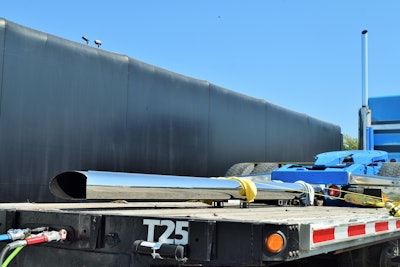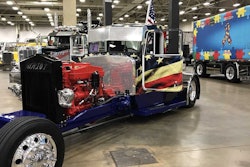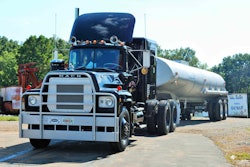At the Guilty by Association Truck Show this past September, I had the opportunity to meet Rick Bestwick, co-owner of the Mel-Rick Inc. business, incorporated by himself and his wife, Melody, in the early 1980s. In the video above, find a series of looks at the four tractors, and two step deck trailers, he hauled to GBATS from his native Sabetha, Kan., where the 10-truck fleet today hauls product in hoppers serving the pet-food industry, in addition to occasional step deck freight.
 At GBATS, given the inaccessibility of a step-deck dock to unload the antique ’74 cabover and needlenose ’61 Peterbilts the Mel-Rick 2016 (right) and ’18 389 Cat-powered gliders hauled to Joplin, the trailers remained loaded for the duration of the show, as did the detached stacks on the 1961 Pete, loaded at the front of the step deck reserved for the 1974 cabover to avoid being overheight for the trip:
At GBATS, given the inaccessibility of a step-deck dock to unload the antique ’74 cabover and needlenose ’61 Peterbilts the Mel-Rick 2016 (right) and ’18 389 Cat-powered gliders hauled to Joplin, the trailers remained loaded for the duration of the show, as did the detached stacks on the 1961 Pete, loaded at the front of the step deck reserved for the 1974 cabover to avoid being overheight for the trip:
The older units were no less impressive for it all.
 In the video at the top, Bestwick details the basic histories of both the ’61 needlenose conventional and the ’74 cabover, with plenty views of both. Each was purchased from a prior owner also with what Bestwick says is either a “hobby” or a joyous kind of “sickness” one, this proclivity to buy and hold onto — and rebuild, thus to preserve — classics like these. Keep an eye out for them at shows within the broad geographical orbit of Northwest Kansas in future, no doubt.
In the video at the top, Bestwick details the basic histories of both the ’61 needlenose conventional and the ’74 cabover, with plenty views of both. Each was purchased from a prior owner also with what Bestwick says is either a “hobby” or a joyous kind of “sickness” one, this proclivity to buy and hold onto — and rebuild, thus to preserve — classics like these. Keep an eye out for them at shows within the broad geographical orbit of Northwest Kansas in future, no doubt.










